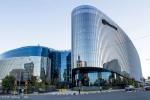South African Office Property Recovery Stays Slow
 South African office property market continues to struggle due to slowing economic growth putting significant pressure on small and medium-sized businesses.
South African office property market continues to struggle due to slowing economic growth putting significant pressure on small and medium-sized businesses.
Although vacancies have reduced, the South African office property market continues to struggle due to slowing economic growth putting significant pressure on small and medium-sized businesses.
Weighed down by pedestrian economic growth, the office market continues to be the laggard of SA’s commercial property market, while the industrial sector is “in equilibrium” and retail property continues to perform well.
Grindrod Asset Management chief investment officer Ian Anderson says there is still much activity across all three sectors, although activity is being driven for different reasons.
“Although we have seen a lot of activity within the retail sector, most of it is tenant driven, whereas in the office and industrial market, there is still a bit of speculative development — but it is being done knowing that the product that is being developed is in demand.”
Mr Anderson says the retail property sector is an area of growing concern. New supply in the retail segment has for the past eight or so years been driven by strong growth in household consumption, which in turn was driven partly by easy consumer access to credit. “Not all of those conditions are in play any more, and I think that increasingly our retailers are going to struggle and therefore our retail landlords will also be under some pressure,” he says.
If rental growth matches retail turnover growth over time, and with turnover growth expected to decline from recently high levels, “at some point there has got to be some pressure on retail rental growth”. However, he says there will be disparities in the performance of retail properties based on their size and location. The regional and super-regional centres “are likely to come through this unscathed”, while smaller community and neighbourhood centres, which have proliferated across the country, will face “fairly substantial risk”.
Mr Anderson says the listed property sector has taken advantage of the opportunity to develop retail centres in previously undersupplied rural areas, driven by rising incomes thanks to access to social grants and the growth of mining towns. But he says that these developments are not as easy as before, and developers and funds need to be careful about where they introduce stock and whether the households in the area are able to support their planned centres.
Meanwhile, the office sector “continues to struggle”, which is a function of slowing economic growth. Mr Anderson says this is “putting significant pressure on small and medium-sized businesses, and even larger businesses are looking to give back a bit of space as they downsize and become more efficient”.
At the same time, there has been substantial new stock introduced into the office sector, particularly near Gautrain stations. However, these developments are housing large tenants, which “are literally moving down the road”, and this is creating vacancies in nearby nodes.
Mr Anderson says the industrial segment of the market seems to be in equilibrium.
“Things are just ticking over and there’s no upward or downward pressure on rentals.”
Growthpoint Properties industrial division director Engelbert Binedell says Growthpoint’s industrial vacancies and arrears “are as low as they have been in the past 10 years”. Mr Binedell says this “speaks to the underlying asset base that we have got and the type of clients that we have got”.
However, he says he expects “things to get tougher”, with slowing economic growth and pressure from large electricity and fuel price increases. Mr Binedell says a diversified industrial portfolio in the market is a more resistant one.
“We are quite resilient at the moment and we are pleased with the underlying performance of the portfolio,” he says.
There has been a clear shift in the industrial property sector away from manufacturing properties towards warehousing and logistics, although the manufacturing industry is still relevant and important, Mr Binedell says.
While the momentum in Gauteng’s industrial division has continued, he says that KwaZuluNatal “is doing particularly well”, with strong demand for space largely due to the province’s aerotropolis and port.
Capital Property Fund executive director Andrew Teixeira says the fund has disposed of many of its manufacturing-type assets and is focused on developing large warehousing, distribution and logistics centres. “I wouldn’t say it’s buoyant but there’s still a level of inquiry when it comes to new A-grade warehouse distribution.”
Mr Teixeira says in Capital’s warehousing, logistics and distribution portfolio, vacancies have declined slightly, although rentals remain “a little bit soft — but once vacancies get to around 3% then you’ll start seeing an uptick in the rentals”.
Demand in KwaZulu-Natal has been relatively strong, and the fund has “basically zero vacancies” in its industrial portfolio in the province.
Capital has focused its attention around the port, and the fund recently bought Clairwood Racecourse, which it intends to develop into a logistics park.
Meanwhile, the office sector is “still struggling” although vacancies have reduced, he says. “But the rental levels are still fairly soft — when you’ve got vacancies sitting at around the 10% level on B-grade offices, it’s going to be weak. We have seen the market improve, but not improve drastically.”
















